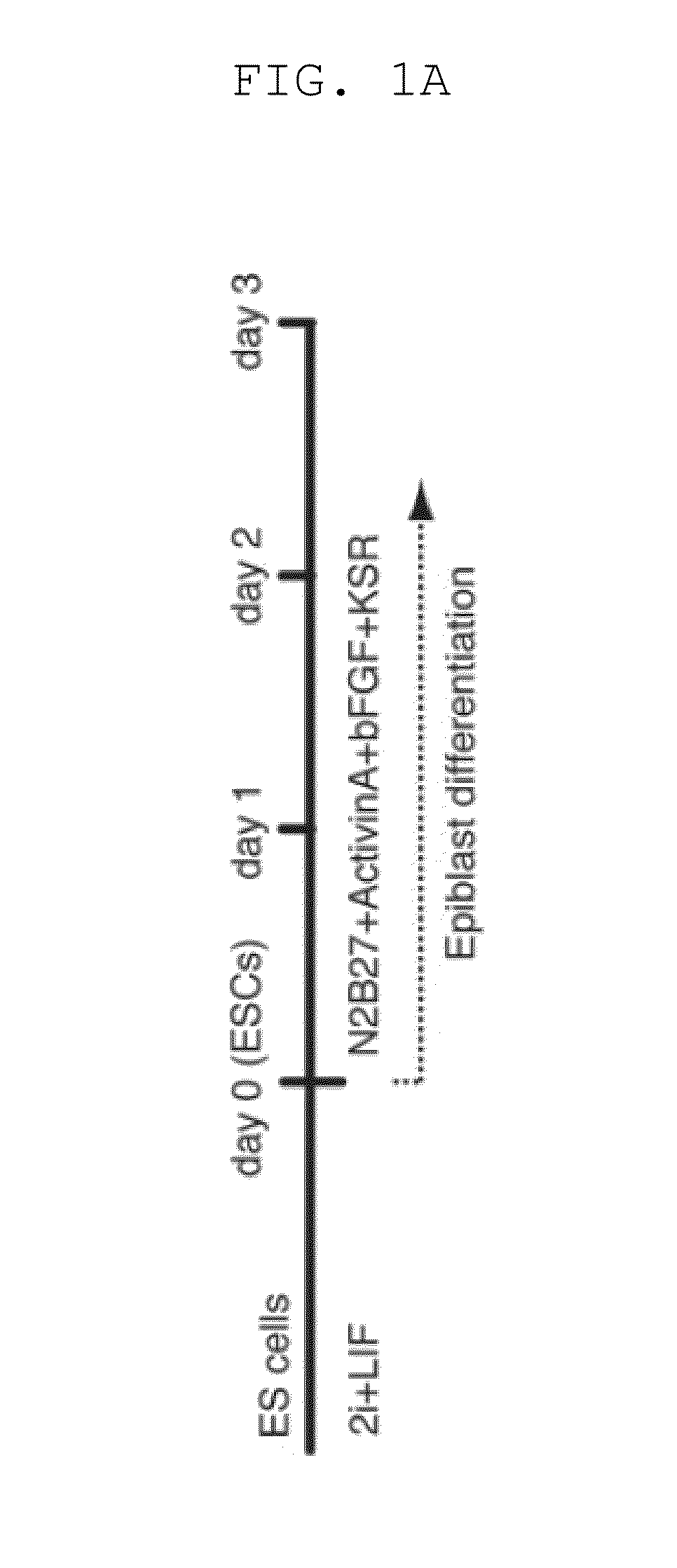Method of inducing differentiation from pluripotent stem cells to germ cells
a technology of germ cells and stem cells, which is applied in the field of inducing differentiation from pluripotent stem cells to germ cells, can solve the problems of inefficient efforts to obtain the cells of interest, culture conditions capable of efficiently and reproducibly inducing, and cells created have never been demonstrated to contribute to the generation of healthy offspring, etc., to achieve high efficiency and reproducibility
- Summary
- Abstract
- Description
- Claims
- Application Information
AI Technical Summary
Benefits of technology
Problems solved by technology
Method used
Image
Examples
example 1
Pre-Gastrulating Epiblast-Like Cells (EpiLCs) from ESCs
[0157]Male ESCs bearing the Blimp1-mVenus and stella-ECFP reporters (BVSC) (Reproduction 136, 503-514 (2008)) on the C57BL / 6 background were derived and maintained in N2B27 medium with an inhibitor against MAPK signalling (PD0325901, 0.4 μM), an inhibitor against GSK3 (CHIR99021, 3 μM), and LIF (1000 U / ml) [2i+LIF], a condition that keeps ESCs in the ˜E3.5-E4.5 ICM / early epiblast-like state (the ground state) (Nature 453, 519-523, doi:nature06968 [pii] 10.1038 / nature06968 (2008); Development 136, 3215-3222, doi:dev.038893 [pii] 10.1242 / dev.038893 (2009)). Among a variety of conditions examined, we found that stimulation, on a fibronectin-coated dish, with activin A (20 ng / ml), bFGF (12 ng / ml), and Knockout™ Serum Replacement (KSR) (1%), resulted in the uniform induction of highly-compacted ESC colonies into more flattened epithelial structures resembling the epiblasts over the course of a 3-day period (FIGS. 1A, B). Upon the sti...
example 2
PGC-Like Cell Induction from ESCs Through EpiLCs
[0159]We next examined whether the EpiLCs are induced into PGC-like cells, as in the case of the pre-gastrulating epiblasts in vivo. Such induction was considered to be a critical indicator of whether or not the EpiLCs bear the functional properties of the pre-gastrulating epiblasts. We cultured the BVSC ESCs and day-1, -2, and -3 EpiLCs under a floating condition (1,000 cells per well of a low-cell-binding U-bottom 96-well plate) in the SFM alone, or in the SFM with LIF (1000 U / ml), or BMP4 (500 ng / ml), or BMP4 and LIF for 2 days. As shown in FIG. 2A, no significant BV induction was observed in any of the aggregates cultured in the SFM alone or SFM with LIF. In contrast, when cultured in the SFM with BMP4 or with BMP4 and LIF, prominent and relatively uniform BV induction was seen specifically in aggregates from day-2 EpiLCs, but not in aggregates from ESCs or day-1 EpiSCs (FIG. 2A). Aggregates from day-3 EpiLCs also exhibited BV indu...
example 3
Gene Expression Dynamics Associated with PGC-Like Cell Induction
[0163]To gain a more critical insight on the process of PGC-like cell induction, we evaluated the gene expression dynamics associated with PGC-like cell induction from the day-2 EpiLCs by Q-PCR (FIG. 2E). While Oct3 / 4 was up-regulated slightly in BV- and BVSC-positive (day 2 and day 4 / 6, respectively) cells, Sox2 and Nanog, which were down-regulated in the day-2 EpiLCs (FIG. 1E), were regained significantly in these PGC-like cells. Genes specifically up-regulated upon PGC specification, including Blimp1, Prdm14, Tcfap2c, Nanos3, stella (Dppa3), Tdrd5, and Dnd1, were all highly elevated in BV- and BVSC-positive cells. In contrast, genes associated with a somatic mesodermal program, such as Hoxa1, Hoxb1, and Snai1, showed transient up-regulation in BV-positive cells at day 2 but subsequently exhibited drastic repression in BVSC-positive cells at day 4 and 6. On the other hand, Dnmt3a and 3b, Np95 encoding a critical co-fa...
PUM
 Login to View More
Login to View More Abstract
Description
Claims
Application Information
 Login to View More
Login to View More - R&D
- Intellectual Property
- Life Sciences
- Materials
- Tech Scout
- Unparalleled Data Quality
- Higher Quality Content
- 60% Fewer Hallucinations
Browse by: Latest US Patents, China's latest patents, Technical Efficacy Thesaurus, Application Domain, Technology Topic, Popular Technical Reports.
© 2025 PatSnap. All rights reserved.Legal|Privacy policy|Modern Slavery Act Transparency Statement|Sitemap|About US| Contact US: help@patsnap.com



